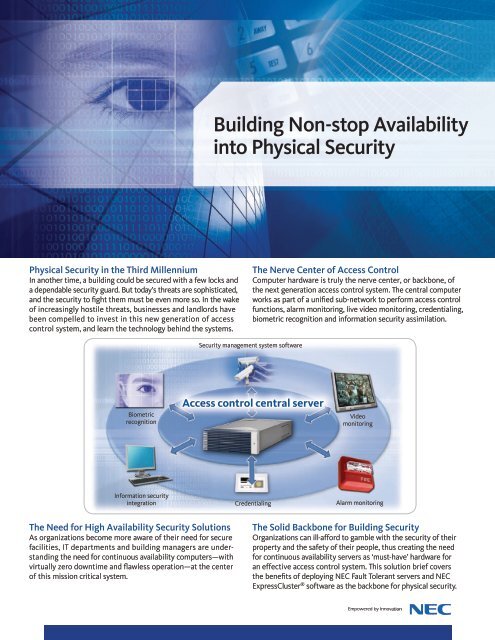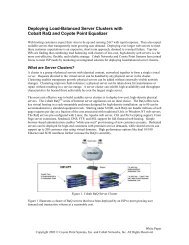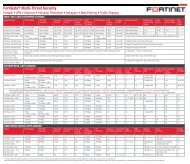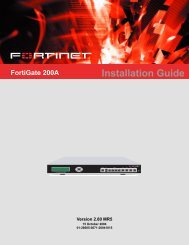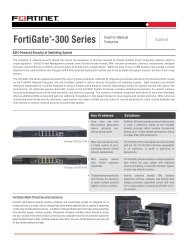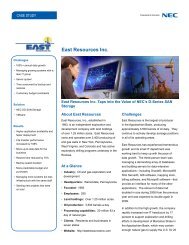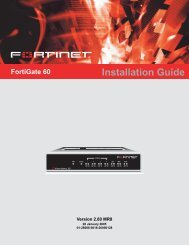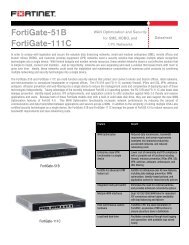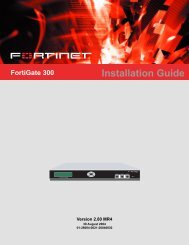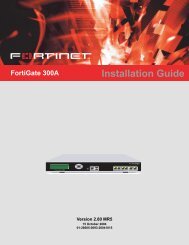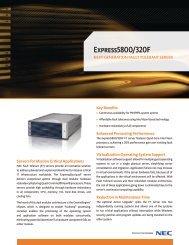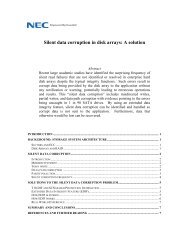Building Non-stop Availability into Physical Security - Foreseeson
Building Non-stop Availability into Physical Security - Foreseeson
Building Non-stop Availability into Physical Security - Foreseeson
You also want an ePaper? Increase the reach of your titles
YUMPU automatically turns print PDFs into web optimized ePapers that Google loves.
<strong>Physical</strong> <strong>Security</strong> in the Third Millennium<br />
In another time, a building could be secured with a few locks and<br />
a dependable security guard. But today’s threats are sophisticated,<br />
and the security to fight them must be even more so. In the wake<br />
of increasingly hostile threats, businesses and landlords have<br />
been compelled to invest in this new generation of access<br />
control system, and learn the technology behind the systems.<br />
Biometric<br />
recognition<br />
The Need for High <strong>Availability</strong> <strong>Security</strong> Solutions<br />
As organizations become more aware of their need for secure<br />
facilities, IT departments and building managers are understanding<br />
the need for continuous availability computers—with<br />
virtually zero downtime and flawless operation—at the center<br />
of this mission critical system.<br />
<strong>Building</strong> <strong>Non</strong>-<strong>stop</strong> <strong>Availability</strong><br />
<strong>into</strong> <strong>Physical</strong> <strong>Security</strong><br />
<strong>Security</strong> management system software<br />
The Nerve Center of Access Control<br />
Computer hardware is truly the nerve center, or backbone, of<br />
the next generation access control system. The central computer<br />
works as part of a unified sub-network to perform access control<br />
functions, alarm monitoring, live video monitoring, credentialing,<br />
biometric recognition and information security assimilation.<br />
Access control central server<br />
Video<br />
monitoring<br />
Information security<br />
integration Credentialing Alarm monitoring<br />
The Solid Backbone for <strong>Building</strong> <strong>Security</strong><br />
Organizations can ill-afford to gamble with the security of their<br />
property and the safety of their people, thus creating the need<br />
for continuous availability servers as ‘must-have’ hardware for<br />
an effective access control system. This solution brief covers<br />
the benefits of deploying NEC Fault Tolerant servers and NEC<br />
ExpressCluster ® software as the backbone for physical security.
2<br />
NEC Fault Tolerant Servers for <strong>Non</strong>-<strong>stop</strong><br />
<strong>Availability</strong> in <strong>Physical</strong> <strong>Security</strong><br />
NEC Fault Tolerant servers are designed and implemented<br />
to ensure continuous availability for Next Generation<br />
access control systems. NEC’s fourth-generation<br />
Express5800/320F Series Fault Tolerant servers<br />
are an affordable solution to delivering redundant<br />
lockstep processing using the latest Intel CPU technology.<br />
With fully redundant hot-swappable server modules<br />
running in lockstep, NEC Fault Tolerant servers deliver<br />
the utmost in continuous availability, even if hardware<br />
in the server fails for any reason. This allows organizations<br />
of any size to realize the highest level of availability and<br />
system integrity, with the added benefit of operational<br />
simplicity.<br />
Affordable Fault Tolerance<br />
Equipped with fully-redundant and hot-swappable<br />
components, including redundant memory processors<br />
and I/O subsystems, NEC Fault Tolerant servers achieve<br />
up to 99.999% uptime equating to about 5 minutes<br />
average downtime per year. NEC’s Fault Tolerant<br />
redundant server architecture eliminates single points of<br />
failures. NEC Fault Tolerant servers deliver the highest<br />
performance and highest availability with Intel ® Xeon<br />
processors at an affordable price.<br />
“<strong>Non</strong>-<strong>stop</strong>” Software Upgrades<br />
NEC Fault Tolerant servers offer Active Upgrade, a<br />
feature that eliminates the need to disrupt server operations<br />
to conduct essential software maintenance. Active Upgrade<br />
enables non-<strong>stop</strong> server operation while performing<br />
software maintenance that often removes other servers<br />
from operation for several hours.<br />
Lower Total Cost of Ownership<br />
NEC is able to deliver continuous availability at substantially<br />
reduced operational costs. Since the FT server<br />
is a single system, it only requires one operating system<br />
and one application software license. Compared to<br />
clustered systems, the FT is a turnkey solution with rapid<br />
and easy system deployment and application setup. It<br />
does not require the administrative resources typically<br />
associated with clustering systems for upgrades and<br />
maintenance. It also results in productivity improvements<br />
by avoiding unplanned hardware outages.<br />
Hardware<br />
Operating<br />
System<br />
TOTAL COST OF OWNERSHIP<br />
Application Install Service Admin Outage<br />
PHASE<br />
Operational Simplicity<br />
With the leading operating systems and virtualization<br />
providers, FT servers implement redundancy at the hardware<br />
level. This approach significantly reduces the complexity<br />
associated with other forms of high availability such as<br />
clustering systems. It also simplifies system management<br />
and recovery operations, since administration and<br />
configurations are performed as a single system view.<br />
A fault tolerant server has two computer server modules with the same components as a conventional server. The FT<br />
Server includes fault detection technology to monitor and failover to the redundant server in the event of a hardware<br />
fault, with no interruption to operational software programs.<br />
COST<br />
FT-Server<br />
Cluster<br />
Traditional<br />
To Clusters<br />
To Traditional
NEC ExpressCluster Software<br />
for <strong>Physical</strong> <strong>Security</strong><br />
NEC ExpressCluster ® X adds quick recovery to access<br />
control systems should the system experience an outage<br />
or a disaster such as fire, terrorism or natural disaster.<br />
NEC ExpressCluster is a family of integrated highavailability<br />
and disaster recovery software solutions<br />
that complement the Fault Tolerant server offering fast<br />
recovery and protection of critical applications and data.<br />
Combined with NEC’s servers, NEC ExpressCluster<br />
minimizes business disruption due to system outages<br />
caused by unplanned or planned situations.<br />
Fast automated application and data recovery<br />
NEC ExpressCluster continuously monitors applications<br />
and system resources such as disk and network I/O on<br />
multiple servers. NEC ExpressCluster provides application<br />
and data recovery in case of unplanned hardware, software,<br />
and site failures within minutes. It offers a comprehensive<br />
protection and recovery not available with other solutions<br />
that only offer data protection. NEC Express Cluster<br />
achieves up to 99.999% uptime for up to 52 minutes<br />
downtime per year on average.<br />
High <strong>Availability</strong><br />
NEC Mirrored Software Cluster<br />
Uptime: 99.9% - 99.99%<br />
Downtime: 1-9 hrs/yr<br />
Hardware <strong>Availability</strong>: 99.9%<br />
Software <strong>Availability</strong>: 99.99%<br />
Scope: LAN<br />
• Local high availability for<br />
transactional systems<br />
• Synchronous data integrity<br />
• Full software redundancy<br />
Continuous <strong>Availability</strong><br />
NEC Fault Tolerant Server<br />
Uptime: 99.99%<br />
Downtime: 5 min/yr<br />
Hardware <strong>Availability</strong>: 99.999%<br />
Software <strong>Availability</strong>: N/A<br />
Scope: Local Only<br />
• Redundant hardware operates<br />
as a single server<br />
• Lockstep failover for hardware<br />
• Hot-swap server modules<br />
<strong>Availability</strong> Downtime<br />
99.999% 5.25 minutes/year<br />
99.99% 52 minutes/year<br />
99.9% 8.76 hours/year<br />
99% 3.65 days/year<br />
90% 36.5 days/year<br />
State of the Art for High <strong>Availability</strong><br />
Data mirroring for virtually no data loss<br />
ExpressCluster product editions offer a choice of data<br />
protection methods from asynchronous data mirroring<br />
for best-effort data protection to synchronous data<br />
mirroring to virtually eliminate data loss risks. Synchronous<br />
mirroring offers highest performance and lowest data<br />
loss risk that are well suited for database driven systems.<br />
Asynchronous mirroring offers best-effort data protection<br />
with lower network infrastructure requirements to meet<br />
the needs of large file content systems that have higher<br />
tolerance for data loss.<br />
Continuous <strong>Availability</strong> +<br />
Disaster Recovery<br />
Mirrored Software & Redundant<br />
Server WAN Cluster<br />
Uptime: 99.999%+<br />
Downtime: 5 min/yr,<br />
plus disaster recovery<br />
Hardware <strong>Availability</strong>: 99.999%<br />
Software <strong>Availability</strong>: 99.99%<br />
Scope: WAN<br />
• System disaster recovery<br />
• Synchronized data integrity<br />
• Low bandwidth and long<br />
distance WAN support<br />
3
NEC Corporation of America<br />
Departmental Servers Division<br />
2880 Scott Blvd.<br />
Santa Clara, CA 95050<br />
www.necam.com/servers<br />
1 866 632-3226<br />
1 408 844-1299<br />
Conventional Server<br />
with HDD RAID<br />
© 2009 NEC Corporation of America. All rights reserved. Specifications are<br />
subject to change without notice. NEC is a registered trademark and Empowered<br />
by Innovation is a trademark of NEC Corporation. All other trademarks are the<br />
property of their respective owners. (SB100-1_0409)<br />
NEC ExpressCluster LAN Edition<br />
with NEC general purpose servers<br />
NEC Fault Tolerant Servers<br />
NEC Fault Tolerant Servers<br />
with NEC ExpressCluster WAN Edition<br />
<strong>Availability</strong> Level Standard <strong>Availability</strong> High <strong>Availability</strong> Continuous <strong>Availability</strong> Continuous <strong>Availability</strong> &<br />
Disaster Recovery<br />
<strong>Availability</strong> Level Description 99.5% uptime or about 44 hours<br />
downtime per year on average<br />
99.9% to 99.99% uptime or about<br />
5 hours downtime per year on<br />
average<br />
Data Protection Methods RAID for application data Synchronous data mirroring of<br />
application data<br />
Potential Loss Application state is lost, but data<br />
is maintained under RAID. Data<br />
must be transferred manual to new<br />
server and restarted<br />
Minimum Platform<br />
Requirements<br />
Application state is momentarily<br />
lost, but data is maintained on a<br />
backup server for fast restart<br />
One server • 2 NEC general purpose servers<br />
• 1 ExpressCluster LAN license<br />
Protection and Recovery Scope Data protection • Hardware failures<br />
• Software crashes<br />
• Data protection<br />
Supported Configurations Standard Server Up to 32 servers over LAN in one<br />
location with up to 8 mirrored data<br />
sets per server<br />
Software Licenses One OS and one application<br />
license for each server<br />
Two OS, two ExpressCluster and at<br />
least two application licenses<br />
Active/Standby Hardware Ratio Standby server only Up to 8 active and 1 standby<br />
servers<br />
User Experience of Failure Extended downtime for manual<br />
system recovery and repair<br />
Goes offline and system is down<br />
until the clustered server comes<br />
back up. All in-flight transactions<br />
will need to be re-initiated<br />
OS support Implementation dependent • Windows Server 2003/2008<br />
Standard or Enterprise<br />
(32- and 64-bit)<br />
• Red Hat Enterprise Linux 4/5<br />
(32- and 64-bit)<br />
• Novell SUSE Linux Enterprise<br />
Server 9/10 (32- and 64-bit)<br />
Implementation and setup Implementation dependent Advanced IT skills required to set<br />
up, configure and install two servers<br />
with operating, application and<br />
cluster software<br />
Cost Range forMinimum<br />
Configuration<br />
99.999% uptime or about 5<br />
minutes downtime per year on<br />
average for hardware protection<br />
Dual servers running in lockstep<br />
with full redundancy of application<br />
processing and data<br />
No loss of application funcitonal<br />
and data. Application continues<br />
to run<br />
99.999%+ uptime or less than 5<br />
minutes downtime per year on<br />
average<br />
Dual servers running in lockstep<br />
for local protection, plus data<br />
mirroring and application<br />
monitoring for fast restart at a<br />
remote location for disaster recovery<br />
No lost of application functionality<br />
or data. For disasters, application<br />
state is momentarily lost, but data<br />
is maintained at a remote location<br />
on a backup server for fast restart<br />
1 NEC Fault Tolerant server • 1 NEC Fault Tolerant server<br />
• 1 NEC general purpose server<br />
• 1 ExpressCluster WAN license<br />
• Hardware failures<br />
• Data protection<br />
• Site disasters<br />
• Hardware failures<br />
• Software crashes<br />
• Data protection<br />
One server resides in one location Up to 32 servers over WAN in two<br />
locations over hundreds of miles<br />
with up to 8 mirrored data sets<br />
per server<br />
One OS and one application Two OS, two ExpressCluster and at<br />
least two application licenses<br />
Single server, but both server<br />
modules are continuously active<br />
Failover is transparent to the<br />
application and there is no<br />
interruption, no lost transactions,<br />
and no degradation in<br />
performance<br />
• Windows Server 2003/2008<br />
Standard or Enterprise<br />
(32- and 64-bit)<br />
• Red Hat Enterprise Linux 4/5<br />
(32- and 64-bit)<br />
• Novell SUSE Linux Enterprise<br />
Server 9/10 (32- and 64-bit)<br />
Turnkey solution with rapid system<br />
deployment; fewer IT resources<br />
required<br />
$3K - $7K per server $22K - $30K $26K - $30K $50K - $60K<br />
Hardware Warranty 1 to 3 years 3 to 5 years 3 years 3 to 5 years<br />
FT server modules are continuously<br />
active as 1 server, plus up to 8<br />
active and 1 standby servers<br />
For hardware failures, failover is<br />
transparent to the application and<br />
there is no interruption, lost data,<br />
or poor performance. For software<br />
and disaster failovers the system<br />
will go offline until the clustered<br />
server comes back online<br />
• Windows Server 2003/2008<br />
Standard or Enterprise<br />
(32- and 64-bit)<br />
• Red Hat Enterprise Linux 4/5<br />
(32- and 64-bit)<br />
• Novell SUSE Linux Enterprise<br />
Server 9/10 (32- and 64-bit)<br />
Advanced IT skills required to set<br />
up, configure and install two servers<br />
with operating, application and<br />
cluster software<br />
4


